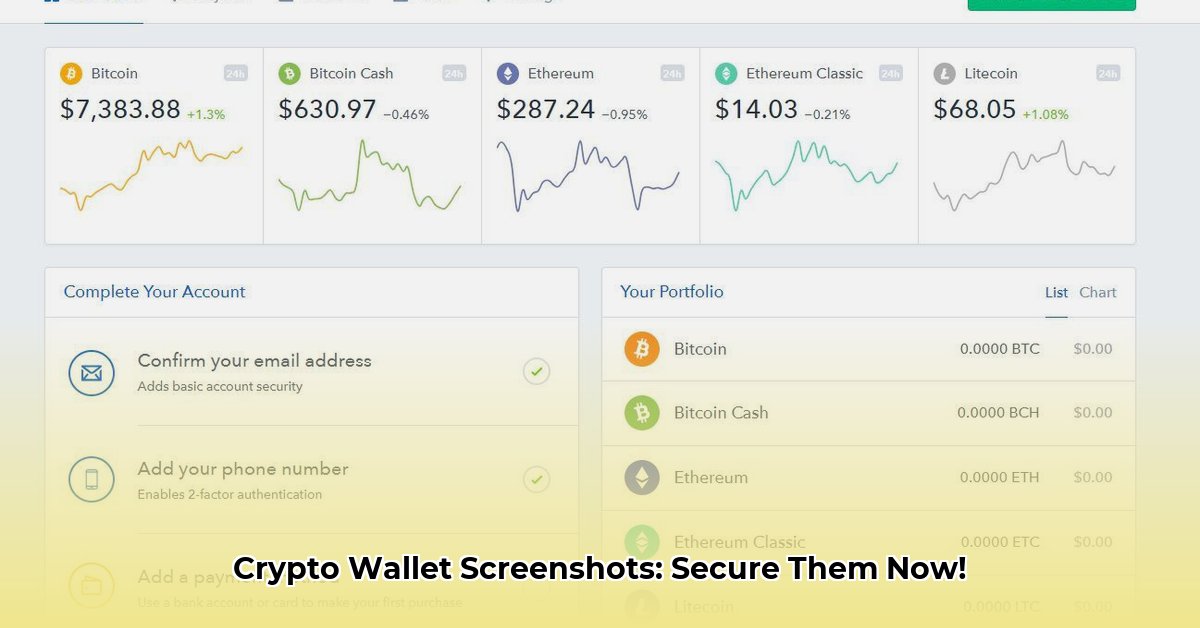
Crypto Wallet Screenshots: A Risky Business? Understanding Secure Verification
Using screenshots of your cryptocurrency wallet for verification might seem convenient, but it's a surprisingly risky practice. This guide explains why screenshots are inadequate and details safer, more robust methods. We'll cover best practices for cryptocurrency exchanges, users, and regulators, providing actionable steps to enhance your crypto security. Do you fully understand the vulnerability inherent in relying solely on visual verification?
Why Crypto Wallet Screenshots Are Inadequate
Imagine leaving your house key under the welcome mat – easily accessible to anyone. A screenshot of your crypto wallet address is similarly vulnerable. Anyone with basic photo-editing skills can alter the amount of cryptocurrency shown or even the wallet address itself. This leaves your funds vulnerable to theft. Furthermore, a screenshot only shows a public key; your private key—the actual control mechanism for your crypto—remains unprotected and could be obtained through nefarious means.
Safer Alternatives: Moving Beyond Screenshots
Fortunately, several secure alternatives exist, offering significantly improved protection against fraud.
1. Multi-Factor Authentication (MFA): Adding Multiple Layers of Security
MFA employs multiple security methods, such as passwords and one-time codes sent to your phone, making unauthorized access far more difficult. This is akin to adding a second lock to your door and dramatically improves security compared to a simple password.
2. Blockchain-Based Verification: Immutable Proof of Ownership
This advanced technique leverages the inherent security of the blockchain, similar to establishing a legally binding, tamper-proof record of ownership. Since it's directly tied to the immutable blockchain, the verification is virtually unalterable. This is the gold standard for secure crypto transactions.
3. Biometric Authentication: Unique Identification
Using biometric data like fingerprints or facial recognition creates a uniquely personal form of authentication. This is comparable to a key that only you possess, providing heightened security against unauthorized access.
How to Securely Verify Cryptocurrency Wallet Addresses Beyond Screenshots
Protecting your cryptocurrency demands more than a simple visual check of a wallet address screenshot. Screenshots are easily manipulated, rendering this method highly insecure. Let's explore robust methods for secure verification.
The Dangers of Screenshot-Based Verification
A screenshot is akin to a photocopy of a bank check – easily forged. Similarly, it’s easy to alter details on a cryptocurrency address screenshot to redirect funds to a scammer's account. Relying on solely visual verification is exceptionally risky.
A Multi-Layered Approach to Secure Verification
Effective verification necessitates a multi-step approach. This comprehensive method reduces the chance of fraud significantly.
Step-by-Step Verification Process
- Format Verification: Confirm the address format aligns with the established norms for the specific cryptocurrency (e.g., Bitcoin, Ethereum). Any discrepancies raise significant concerns.
- Checksum Validation: Many cryptocurrencies utilize checksums (error detection codes) for typo detection. Use online tools to validate these preventing errors and confirming integrity.
- Reputable Validation Tools: Utilize trusted online tools designed for address validation. However, always be cautious of phishing websites imitating legitimate services.
- Test Transaction (Small Amount): Before transferring substantial funds, send a small test transaction. This confirms the address receives funds without substantial risk.
- Transaction History Review (Advanced): For enhanced security, examine the address's transaction history on a blockchain explorer for any signs of suspicious activity.
Pros and Cons of Different Verification Methods
| Method | Pros | Cons |
|---|---|---|
| Visual Inspection | Quick and easy | Highly unreliable; easily manipulated; insufficient for security. |
| Online Validation Tools | Accurate; detect errors; relatively quick | Relies on third-party services; potential for phishing scams. |
| Test Transaction | Verifies address functionality; reduces risk | Requires sending funds; minor cost involved. |
| Blockchain Explorer Analysis | Comprehensive; reveals transaction history | Requires technical knowledge; time-consuming; data might be incomplete. |
Key Takeaways:
- Avoid relying solely on visual inspection of wallet addresses.
- Implement a multi-layered verification approach.
- Use reputable, verified online validation tools.
- Always conduct a small test transaction before significant transfers.
- Thoroughly understand the correct address formats for all cryptocurrencies used.
- Maintain constant vigilance against phishing attempts.